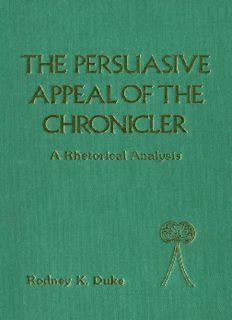
The Persuasive Appeal of the Chronicler: A Rhetorical Analysis of the Books of Chronicles PDF
Preview The Persuasive Appeal of the Chronicler: A Rhetorical Analysis of the Books of Chronicles
JOURNAL FOR THE STUDY OF THE OLD TESTAMENT SUPPLEMENT SERIES 88 Editors David J.A. Clines Philip R. Davies BIBLE AND LITERATURE SERIES 25 General Editor David M. Gunn Assistant General Editor Danna Nolan Fewell Consultant Editors Elizabeth Struthers Malbon James G. Williams Almond Press Sheffield This page intentionally left blank THE PERSUASIVE APPEAL OF THE CHRONICLER A Rhetorical Analysis Rodney K. Duke The Almond Press • 1990 Bible and Literature Series, 25 General Editor: David M. Gunn (Columbia Theological Seminary, Decatur, Georgia) Assistant General Editor. Danna Nolan Fewell (Perkins School of Theology, Dallas, Texas) Consultant Editors: Elizabeth Struthers Malbon (Virginia Polytechnic Institute & State University, Blacksburg, Virginia) James G. Williams (Syracuse University, Syracuse, New York) Copyright © 1990 Sheffield Academic Press Published by Almond Press Editorial direction: David M. Gunn Columbia Theological Seminary P.O. Box 520, Decatur GA 30031, U.S.A. Almond Press is an imprint of Sheffield Academic Press Ltd The University of Sheffield 343 Fulwood Road Sheffield S10 3BP England Typeset by Sheffield Academic Press and printed on acid-free paper in Great Britain by Billing & Sons Ltd Worcester British Library Cataloguing in Publication Data Duke, Rodney K. The persuasive appeal of the chronicler. 1. Bible. O.T. Chronicles—Critical studies I. Title II. Series 222.606 ISSN 0260-4493 ISSN 0309-0787 ISBN 1-85075-228-1 CONTENTS Acknowledgments 9 Chapter 1 INTRODUCTION 11 A. The Objective of the Study 11 B. The Place of this Study in Chronicles Research 11 1. Major Trends in Chronicles Research 11 a. Prior to the Nineteenth Century 12 b. Nineteenth Century 13 c. Twentieth Century 22 2. Conclusion: The Place of this Book in Chronicles Research 28 C. Methodological Concerns 29 1. The Meaning of 'Rhetoric' 29 2. The Rhetorical Nature of Historical Narratives 31 3. The Nature and Goal of a Rhetorical Analysis 33 4. The Designation of Chronicles as a Rhetorical Unit 35 5. Reading Chronicles with Regard to Samuel-Kings 36 6. The Utilization of Aristotle's Rhetoric 3 7 D. Aristotle's 'Rhetoric' 39 1. Introduction 39 2. The Parts of Rhetoric 40 3. Modes of Persuasion 43 4. Types of Rhetorical Speech 45 Chapter 2 PURPOSE, STRUCTURE, AND TYPE OF RHETORIC 47 A. Introduction 47 B. A Purpose of the Chronicler 47 C. Structure 51 1. Introduction 51 2. Examination of the Structure 54 a. Thesis: David and Solomon as the Paradigm for Seeking Yahweh 54 b. 1 Chronicles 1—9: The Introduction 54 c. 1 Chronicles 10-2 Chronicles 9: The Davidic and Solomonic Paradigm 56 d. 2 Chronicles 10-36: The Davidic Kings 66 3. Analysis of the Structure 69 a. Structure and the Laws of Reality 70 b. Character Portrayal and Classification 72 c. Summary 74 D. Type of Rhetoric 74 Chapter 3 LOGOS: THE RATIONAL MODE OF PERSUASION 81 A. Introduction to Aristotle's Concept 81 B. Application to Chronicles 83 1. Demonstration through the Enthymeme and Example 83 a. The Argument 83 b. Illustration of the Enthymeme 84 c. Illustration of the Example 85 2. The Logical Structure of the Argument 86 a. Introduction to the Topoi 86 b. Commonplaces 87 c. Special Topics 88 d. Conclusion over the Material Topoi: Commonplaces and Special Topics 92 e. Common Topics 92 3. The Development and Complementary Use of Enthymemes 95 a. Introduction 95 b. 1 Chronicles 1-9 96 c. 1 Chronicles 10: Saul 96 d. 1 Chronicles 11-2 Chronicles 9: David and Solomon 98 e. 2 Chronicles 10-36: The Davidic Kings 102 C. Summary and Conclusion 103 Chapter 4 ETHOS: THE ETHICAL MODE OF PERSUASION 105 A. Introduction 105 1. Aristotle's Criteria 105 2. Tentative Conclusions 107 3. Method for Further Analysis 109 B. Analysis 111 1. Material Parallel to Samuel-Kings: Traditional Material 111 a. Methodological Assumptions 111 b. Evaluation of the Chronicler's Use of Tradition 112 2. Unique Material I: External Proofs 116 a. Introduction 116 b. Lists and Genealogies 117 c. Citation of Sources 118 d. Direct Speech 119 3. Unique Material II: Evaluatory Narrative Comments 135 Chapter 5 PATHOS: THE EMOTIONAL MODE OF PERSUASION 139 A. Introduction 139 B. Analysis 141 1. Themes and Motifs 141 2. Character Portrayal and Typology 143 3. Emplotment: The Kind of Story Told 144 4. The Argument: Maxims and Historical Examples 144 5. Direct Address through Speeches 146 C. Summary 147 Chapter 6 CONCLUSIONS 149 A. Summary 149 B. Direction for Further Reflection 151 Appendix List 1: Narrative Comments with 'Seeking* Enthymeme 155 List 2: Speech Material with 'Seeking* Enthymeme 159 List 3: Speech Material without 'Seeking' Enthymeme 163 List 4: Divine Speech Material 167 List 5: Royal Prayers 169 List 6: Royal Speeches 171 List 7: Royal Statements 173 List 8: Prophetic Speech Material 175 Bibliography 177 Index of Biblical References 185 Index of Authors 191 ACKNOWLEDGMENTS To both Robert Detweiler and Robert Paul of Emory Univer- sity, I express my gratitude for expanding my horizons and introducing me to methods of literary criticism which I have brought over to my field of biblical studies. To John Hayes of Emory University and David Gunn of Columbia Theological Seminary, I am indebted for their advice and encouragement on this project. However it is Jane, my wife and best friend, to whom I dedi- cate this work in acknowledgment of her inestimable support and of the great sacrifices she has made for me: Many daughters have done nobly, But you excel them all (Proverbs 31.29).
